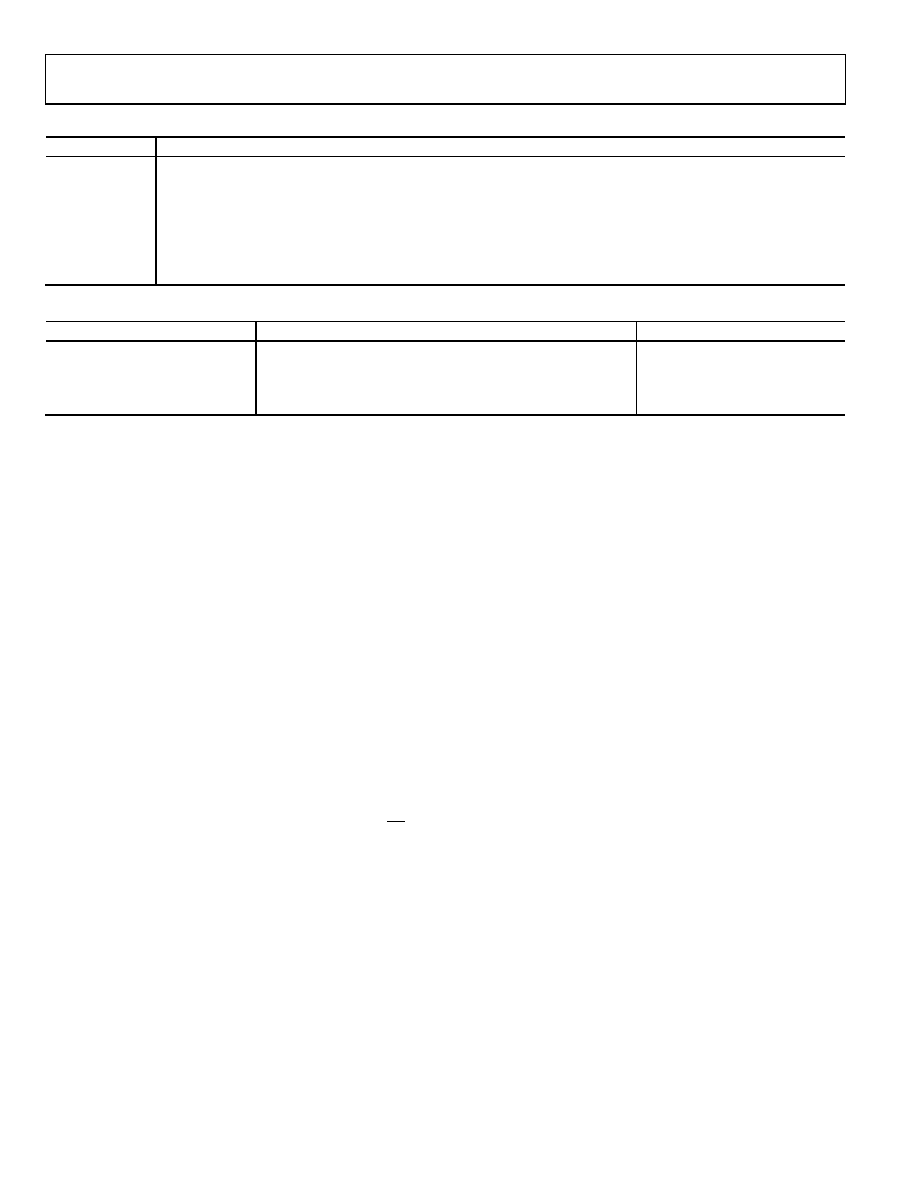- 您現(xiàn)在的位置:買賣IC網(wǎng) > PDF目錄17059 > AD9717-DPG2-EBZ (Analog Devices Inc)ADC 14BIT DUAL 40LFCSP PDF資料下載
參數(shù)資料
| 型號(hào): | AD9717-DPG2-EBZ |
| 廠商: | Analog Devices Inc |
| 文件頁數(shù): | 37/80頁 |
| 文件大小: | 0K |
| 描述: | ADC 14BIT DUAL 40LFCSP |
| 標(biāo)準(zhǔn)包裝: | 1 |
| 系列: | TxDAC® |
| DAC 的數(shù)量: | 2 |
| 位數(shù): | 14 |
| 采樣率(每秒): | 125M |
| 數(shù)據(jù)接口: | 串行 |
| DAC 型: | 電流 |
| 工作溫度: | -40°C ~ 85°C |
| 已供物品: | 板 |
| 已用 IC / 零件: | AD9717 |
第1頁第2頁第3頁第4頁第5頁第6頁第7頁第8頁第9頁第10頁第11頁第12頁第13頁第14頁第15頁第16頁第17頁第18頁第19頁第20頁第21頁第22頁第23頁第24頁第25頁第26頁第27頁第28頁第29頁第30頁第31頁第32頁第33頁第34頁第35頁第36頁當(dāng)前第37頁第38頁第39頁第40頁第41頁第42頁第43頁第44頁第45頁第46頁第47頁第48頁第49頁第50頁第51頁第52頁第53頁第54頁第55頁第56頁第57頁第58頁第59頁第60頁第61頁第62頁第63頁第64頁第65頁第66頁第67頁第68頁第69頁第70頁第71頁第72頁第73頁第74頁第75頁第76頁第77頁第78頁第79頁第80頁

AD9714/AD9715/AD9716/AD9717
Rev. A | Page 42 of 80
Table 15. Timer Register List
Bit Name
Description
CLKMODEQ[1:0]
Q data path retimer clock selected output. Valid after the searching bit goes low.
Searching
High indicates that the internal data path retimer is searching for the clock relationship (DAC is not usable until it is low again).
Reacquire
Changing this bit from 0 to 1 causes the data path retimer circuit to reacquire the clock relationship.
CLKMODEN
0: uses CLKMODEI/CLKMODEQ values (as computed by the two internal retimers) for I and Q clocking.
1: uses the CLKMODE value set in CLKMODEI[1:0] to override the bits for both I and Q retimers (that is, force the retimer).
CLKMODEI[1:0]
I data path retimer clock selected output. Valid after searching goes low.
If CLKMODEN = 1, a value written to this register overrides both the I and Q automatic retimer values.
Table 16. CLKMODEI/CLKMODEQ Details
CLKMODEI[1:0]/CLKMODEQ[1:0]
DCLKIO-to-CLKIN Phase Relationship
RETIMER-CLK Selected
00
0° to 90°
Phase 2
01
90° to 180°
Phase 3
10
180° to 270°
Phase 3
11
270° to 360°
Phase 1
When RESET is pulsed high and then returns low (the part is in
SPI mode), the retimer runs and automatically selects a suitable
clock phase for the RETIMER-CLK within 128 clock cycles. The
SPI searching bit, Bit 4 of SPI Address 0x14, returns to low,
indicating that the retimer has locked and the part is ready for
use. The reacquire bit, Bit 3 of SPI Address 0x14, can be used to
reinitiate phase detection in the I and Q retimers at any time.
CLKMODEQ[1:0] and CLKMODEI[1:0] of SPI Address 0x14
provide readback for the values picked by the internal phase
detectors in the retimer (see Table 16).
To force the two retimers (I and Q) to pick a particular phase
for the retimer clock (they must both be forced to the same
value), CLKMODEN, Bit 2 of SPI Address 0x14, should be set
high and the required phase value is written into CLKMODEI[1:0]
and CLKMODEQ[1:0]. For example, if the DCLKIO and the
CLKIN are in phase to the first order, the user can safely force the
retimers to pick Phase 2 for the RETIMER-CLK. This forcing
function may be useful for synchronizing multiple devices.
In pin mode, it is expected that the user tie CLKIN and DCLKIO
together. The device has a small amount of programmable
functionality using the unused SPI pins (SCLK, SDIO, and CS).
If the two chip clocks are tied together, the SCLK pin can be
tied to ground, and the chip uses a clock for the retimer that is
180° out of phase with the two input clocks (that is, Phase 2,
which is the safest and best option). The chip has an additional
option in pin mode when the redefined SCLK pin is high. Use
this mode if using pin mode, but CLKIN and DCLKIO are not
tied together (that is, not in phase). Holding SCLK high causes
the internal clock detector to use the phase detector output to
determine which clock to use in the retimer (that is, select a
suitable RETIMER-CLK phase). The action of taking SCLK
high causes the internal phase detector to reexamine the two
clocks and determine the relative phase. Whenever the user
wants to reevaluate the relative phase of the two clocks, the
SCLK pin can be taken low and then high again.
ESTIMATING THE OVERALL DAC PIPELINE DELAY
DAC pipeline latency is affected by the phase of the RETIMER-
CLK that is selected. If latency is critical to the system and must
be constant, the retimer should be forced to a particular phase and
not be allowed to automatically select a phase each time.
Consider the case in which DCLKIO = CLKIN (that is, in
phase), and the RETIMER-CLK is forced to Phase 2. Assume
that IRISING is 1 (that is, Q data is latched on the rising edge
and I data is latched on the falling edge). Then the latency to the
output for the I channel is three clock cycles (D-FF 1, D-FF 3,
and D-FF 4, but not D-FF 2 because it is latched on the half
clock cycle or 180°). The latency to the output for the Q channel
from the time the falling edge latches it at the pads in D-FF 0
is 2.5 clock cycles ( clock cycle to D-FF 1, 1 clock cycle to
D-FF 3, and 1 clock cycle to D-FF 4). This latency for the AD9714/
AD9715/AD9716/AD9717 is case specific and needs to be calcu-
lated based on the RETIMER-CLK phase that is automatically
selected or manually forced.
相關(guān)PDF資料 |
PDF描述 |
|---|---|
| GCM11DSEI-S243 | CONN EDGECARD 22POS .156 EYELET |
| ADR444ARZ-REEL7 | IC VREF SERIES PREC 4.096V 8SOIC |
| AD9716-DPG2-EBZ | ADC 12BIT DUAL 40LFCSP |
| VE-B6L-EY | CONVERTER MOD DC/DC 28V 50W |
| ADR443ARZ-REEL7 | IC VREF SERIES PREC 3V 8-SOIC |
相關(guān)代理商/技術(shù)參數(shù) |
參數(shù)描述 |
|---|---|
| AD9717-EBZ | 制造商:Analog Devices 功能描述:DUAL 14B, LOW POWER D-A CONVERTER - Boxed Product (Development Kits) |
| AD9720BN | 制造商:Rochester Electronics LLC 功能描述:10BIT 400MSPS DAC IC IC - Bulk |
| AD9720BR | 制造商:Analog Devices 功能描述:PARALLEL, WORD INPUT LOADING, 0.0045 us SETTLING TIME, 10-BIT DAC, PDSO28 |
| AD9720TE | 制造商:未知廠家 制造商全稱:未知廠家 功能描述:10-Bit Digital-to-Analog Converter |
| ad9720te/883b | 制造商:Rochester Electronics LLC 功能描述:- Bulk 制造商:Analog Devices 功能描述: |
發(fā)布緊急采購,3分鐘左右您將得到回復(fù)。